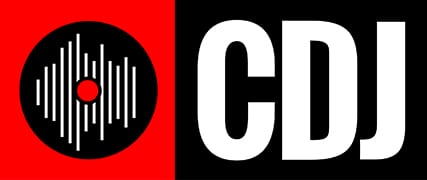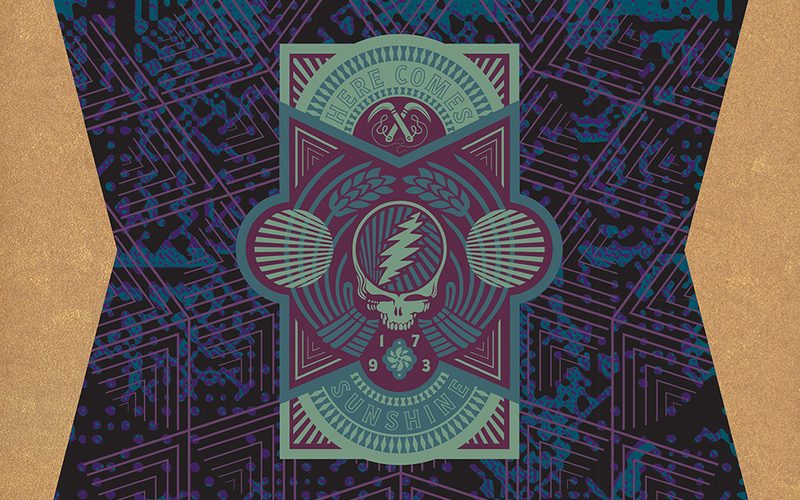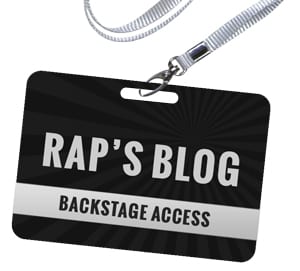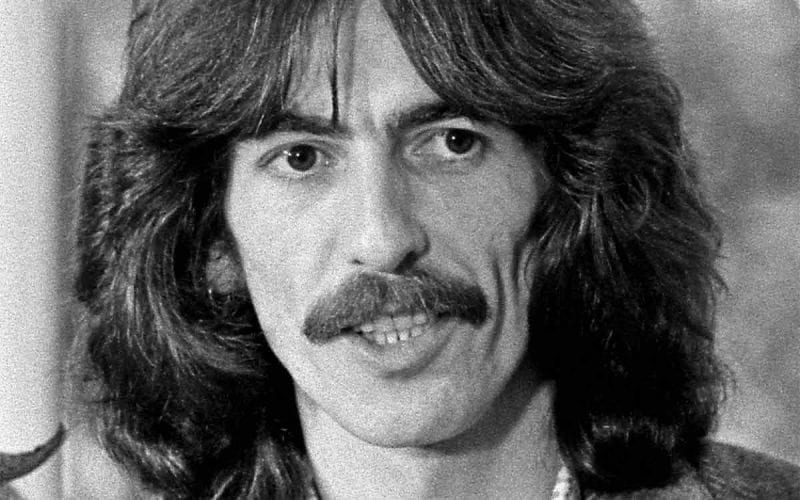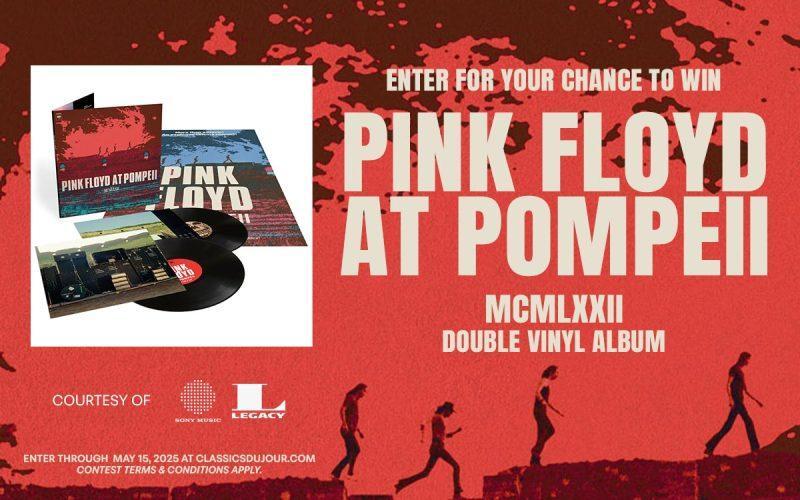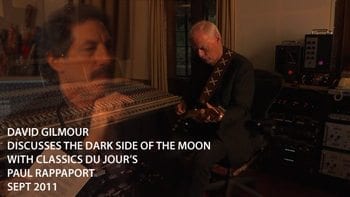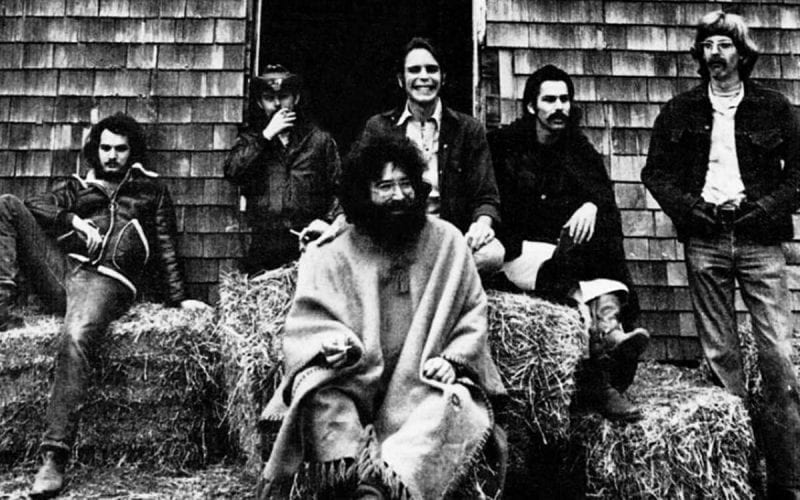
Jerry Garcia – “Music should be holy. When it becomes a business and the music is designed to make money, then the music doesn’t do what it’s supposed to do.”
That is a mouthful, and a statement that a philosophy major, like myself could write a term paper on. But don’t worry I won’t be delving into any “what is the meaning of art?” kind of stuff. However, this will get a bit deep in that in order to explain the Grateful Dead I also need to also explain the psychedelic experience. So please bear with me as once you understand that, the larger phenomenon known as the Grateful Dead and why they have so many loyal fans and followers will become more clear.

This is very important to me as for years I’ve tried in vain to explain it to many friends who just don’t get it. My constant efforts to prove that the Dead’s music is some of the greatest ever made and why Jerry Garcia is a one of a kind Shaman and should be considered as one of the greatest guitarists of all time usually results in my friends shaking there heads, sighing, and saying something like, “There you go again, you drank the Kool-Aid (believed in some sort of magic promoted by fans, the band or both), and just like all those other Dead Heads now you want to preach those insane ideas about how amazing the Grateful Dead and Jerry Garcia are. It’s not true, it’s just something made up in all of your heads for some reason.”
But it’s not made up, and the phenomenon is explained so well in the new recently released Grateful Dead documentary Long Strange Trip it was a revelation to me.
First, let me say that Dead Heads will love this series of six, one hour long episodes now streaming on Amazon. But even more important I hope many other lovers of music will watch this film so at least, whether they ever learn to enjoy the Grateful Dead’s music or not, they will finally understand what all of the hubbub has been about.
I used to try and explain this intrinsic goodness by playing my non-believer friends the best tracks I could find with the very best Jerry guitar solos and then I’d get excited and say, “See? Don’t you HEAR that??! Isn’t that amazing?!!!” And somehow what I heard, they just couldn’t hear. This would frustrate me to no end and I could never figure out why. Or at least why they couldn’t even agree that the guitar solo was incredible. I chalked it up to just a difference in style appreciation or perhaps the Dead were just an acquired taste. What I realized after watching this captivating documentary is the truth has been there all these years staring me in the face but I just didn’t connect the dots.
I never realized how much the Dead’s music and appreciation of it comes down to the psychedelic experience, or at least, the getting high experience. The overall major point is, that indeed, I had drunk the Kool-Aid, but not figuratively, literally!
Before I get into that, I’d like to set the stage with a few cultural and historical facts. The members of the Grateful Dead (first known as The Warlocks) were six guys who all came together from different American genres of music. Jerry Garcia was a bluegrass banjo player, Bob Weir came from the folk movement, Ron “Pigpen” McKernan was a blues guy—played harp and organ, Phil Lesh was a neo-classical composer who hadn’t even played bass before, Mickey Hart was an R&B session drummer who had worked with Aretha Franklin, and Bill Kreutzmann was a jazz drummer who famously had trouble keeping time, but always felt the “feeling” was more important than keeping exact time.
Originally they played bluegrass and folk music. When you play bluegrass music the instruments talk to each other, there is a call and response going on in the solos, as each player takes a turn to say something with their solo, they in turn hand off the music to another player who answers with what he and his instrument has to say. This requires each member listening to one another, and playing off one another as they try to tell a complete story as one band. As Phil Lesh states, “It’s like the fingers in a hand, each can do separate tasks, but they are also all joined together in the hand as one unit.”

When the band went electric, which was just natural evolution at the time, this dynamic continued. Also Jerry Garcia put heavy pressure on all the other members to continually practice their instruments. There was a huge work ethic amongst the band members. This is something that I never knew. Like most, I figured these guys just sat around and got high all the time. There was a point later on when the band got heavily into drugs, but learning this fact validated my belief that no band or artist achieves this kind of longevity or greatness without a strong work ethic.
Garcia used to practice scales for many hours, even during his heavy drug years. Bob Weir tried to keep up, “Yeah, he’s telling me to practice, practice, but it’s not easy when the guy across the room (Garcia) can just seem to play anything he wants at will.”
The band lived together in an old Victorian house in the Haight-Ashbury district of San Francisco along with many other artists and hippies who were creating the counter-culture of the time. People were taking drugs not to escape, but rather to help expand the mind by delving into new ideas and philosophies. Beat poetry was popular, authors like Jack Kerouac, Allen Ginsberg, John Paul Sartre, and Albert Camus were being read and discussed—many were rebelling against what they thought was a “straight” and narrow lifestyle—these folks did not want to be imprisoned in typical societal boxes. The old ways made less sense—why did war still exist?? A new, more enlightened, world was being sought.
All this was going down when Ken Kesey came to town with his psychedelic bus, his band of Merry Pranksters, and most importantly, with large batches of LSD. Ken Kesey, for those who don’t know, is an American novelist who wrote “One Flew Over The Cuckoo’s Nest” and “Sometimes a Great Notion.” He considered himself a link between the Beat Generation of the 1950s and the hippies of the 1960s. He started hosting “happenings” which also became known as the “Acid Tests” where he integrated consumption of LSD with multimedia performances. He mentored the Grateful Dead who became the house band for these parities.
Take this hard working band, made up of six members all steeped in different genres of American music, accomplished at listening to one another to really be able to play off and with each other to bring a new kind of musical experience to an audience and as the documentary says, “Add a healthy dose of LSD and stir vigorously!”
To understand what happened next you need to know what happens to the mind when one takes LSD.
I can speak first hand having gone on a few LSD and Mescaline trips in the late 60’s. Aside from the now legendary hallucinations that you are likely to see, one of the most important facts about an LSD experience is that when you take the drug it magnifies your feelings and ideas. It opens your mind to be totally free and you tap into your most inner human self without any social restrictions or inhibitions that you have been taught along the way in life—you somehow get a look into what life really means—you see it with your very original human instincts.

Let me explain with this example. Believe it or not, LSD came to light when it was first used by the military to see if it could become a viable weapon if given to the enemy. Many tests were done and you can see a couple shown in this documentary. They administered the drug to some American Army troops and then tried to give them directions. They wanted certain leaders, Captains, Sergeants, etc. to give orders to the rest of the platoon and see what would happen. But in this new state of mind, the leaders did not want to give orders–they felt it unfair to the others because they realized that aside from rank, that in fact as human beings, they were all equals.
It’s something that the Rastafari in Jamaica understand, which is why you always hear them referring to each other as “I” and “I” not “you” and “me.” The “I” referring to the fact that there is no difference between us, everyone is an “I” and therefor equal.
When taking the drug you also feel incredibly euphoric, almost brought to tears with the fact of how amazing life can be and your heart opens naturally to the love for other human beings and in a way in which you might have had as a child, wanting to share your love with everyone before you learned about social constraints like competition, class, race discrimination, and celebrity. You lose your ego, you are not so important as YOU, but more important as your role in the Universe and the part you play as how you relate to others and the planet. You seem to understand how everything makes sense and fits.
I witnessed this myself once on a Mescaline trip in Topanga Canyon and sitting on my favorite “thinking spot” (even when not on psychedelic drugs) Saddle Peak. It’s a rock formation on the highest ground where you can overlook the canyon to the west and see all the way to the Pacific Ocean. This vision came to me—in one giant flash I saw what appeared to be the meaning of life. It was like a revelation—I some how received this understanding that indeed, we were all one, not just us humans, but the plants, trees, and even the rocks. We were (are) connected in some large cosmic way.
This feeling is talked about in history—it is something that the American Indians understood. When a brave killed a fish for food he would say a prayer, something like, “I am sorry to have killed you my brother, but I have to feed my family, etc., etc.” The brave would then pray that the fish’s soul would travel to the spirit world where everyone would meet eventually. There was a real respect for the equality of everything, whether it was a buffalo, a tree, or a river—there was a true sense of how the earth worked.
I realize I was on a powerful drug when all of this became clear to me, but it’s not too hard to think logically if we all, and all of our surroundings, somehow evolved from the original Big Bang (God’s creation not withstanding), if you tap into our innermost DNA with deep memories dating back to the beginning of time, we might all might feel as one, emanating from the same place.
At any rate, when Kesey showed up, the Grateful Dead began to take LSD—a lot of LSD. So much so, that they learned to control their trips and be able to actually work while on the drug. This is an important point because it’s so hard to do. The mind tends to wander on the drug and when playing guitar for instance, one might get involved with how the guitar was made, staring at the grains in the wood, the glistening strings, etc., etc., which would be typical. But these guys worked hard to be able to harness the psychedelic power and put it into their music.
Herein lies the magic of The Grateful Dead. With a psychedelic mindset the band were transported to a higher plain, and their music developed based on what they were seeing, hearing, and experiencing in that new state of mind. And this music seemed to just come to them magically from above—that same kind of universal understanding and euphoria was now harnessed and delivered to the masses through their music. The band weren’t stars or seen as celebrities. Because their egos were no longer important there was no real front man, and no front man needed as the band jammed together and went on long musical journeys where each instrument was as important as the next–working more like a catalyst that took everyone on these magical musical trips. Both band and audiences bonded as one and it was very powerful and an incredibly wonderful feeling.
The band became popular with audiences raving about their performances because the audiences’ minds were in exactly the same place as the band. The LSD scene had started small with all those private parties, but as the popularity of the drug grew so did the audiences who would drop acid and go to a show. A show that lasted at least four hours and which could sometimes turn into an all-nighter was no problem, in fact that seemed correct and natural – the average LSD trip lasts eight hours. And the long jams? All of it makes sense when you’re on the drug because when tripping you feel like you are on a long journey. Once your mind attaches to something you will stay glued to that something for hours. We loved those long musical adventures and segues which all resolved back into the choruses of their now famous songs. It all made incredible sense, felt right.

Garcia found the name The Grateful Dead in a dictionary, and it came to symbolize the fact that when you died you were transformed to another state. Perfect for a band that would leave normal reality (die so to speak) and be reborn anew each evening where rehearsed and polished arrangements were eschewed in favor of long improvisational jams that took the audiences to amazing places and new heights.
In this way, the music was seen as “holy,” as Garcia said, because it came naturally from somewhere above and did what “it was supposed to do”— lift our spirits, and heal us in many ways. That is why the Dead let everyone tape their shows. The band felt they had tapped into some kind of magic that was a gift from the Universe, and because they didn’t create it themselves, well how can you charge for magic and smiles that are a gift from the Universe?
So, what happens when you see the Grateful Dead not high on psychedelics? Originally we always went to see the Dead high on acid, mescaline, or copious amounts of marijuana. I remember one very important show that my friend and I attended at the Hollywood Bowl to see the band and hear their new “wall of sound” which was basically the biggest sound system ever built at the time. Boasting eighty-nine 300-Watt solid-state and three 350-Watt vacuum tube amplifiers, it generated a total of 26,400 Watts of audio power through 604 speakers!! It was the greatest sound I’ve ever heard in concert, it was like a hi-fidelity audio set in your living room, except you were at the Hollywood Bowl! You could hear every string of every guitar with absolutely zero distortion. When Phil Lesh hit a bass note it filled the entire bowl — warm and oozing and you could physically feel it, you were surrounded by it. Garcia’s solos seem to come at you from all directions.
But on this evening we went straight—no drugs. Because we wanted to see if the band was as good as we thought or was it just us always being amped on psychedelics that somehow tricked us into thinking they were that great. Well, they were amazing as always, at least to our ears. We enjoyed the show just as much (well almost) and were able to dig all the long jams and feel that one camaraderie with our fellow Dead Heads who were bopping and dancing in the aisles.
One doesn’t really think about it, but after you take LSD, the memory of those insights and larger understandings about the universe and euphoria that you feel stay in your memory banks. If you are a Grateful Dead fan, whenever you hear the music you easily fall right back into its grasp and you are THERE again. Once you’ve taken the drug, you don’t ever need to take it again to tap into that place, your mind remembers it all.
So herein lay my big revelation about the music and the frustration of trying to explain the Grateful Dead to those who just don’t get it.

Even though I am playing the music for friends who are uninitiated with the psychedelic mindset, I have always thought because we were both listening to it totally straight, that we are hearing the same thing. But that’s where I missed it. The truth is that we are listening with two very different sets of ears. They hear the music through traditional Juilliard School of music ears, where every note should be played perfectly etc., etc., while I am hearing it with that psychedelic memory, tapping into that other place, the place from where the music was created. I find myself easy, at home, and at one with every note—it all makes sense to me. The music is baked into my memory banks via that psychedelic experience and the truth is no matter how great my music examples are, even if I pick the best songs with the greatest Jerry Garcia solos, my friends will never be able to understand because they have no bridge to get to that place, and so the music seems foreign to them.
That doesn’t mean that I urge you drop acid, lock yourself in a room, and listen to the now famous Dick’s Picks best of the live Grateful Dead performances ever–far from it. Alas, nothing lasts forever and this music was created in a special time, place, and culture. But that is why back in the day you always used to see posters and bumper stickers that read, “There is nothing like a Grateful Dead concert!” How could there be?
Well, this blog has been just about as long as a Grateful Dead jam—ha! If you’ve managed to stay with me I hope I brought you some insights. At any rate, I highly recommend Long Strange Trip. It certainly was, and still is. You can watch it here, on Amazon.
All the best to our CJD readers, and I promise next blog I will keep it simple (or for me, at least simpler!)
Rap~
© Paul Rappaport 2017
